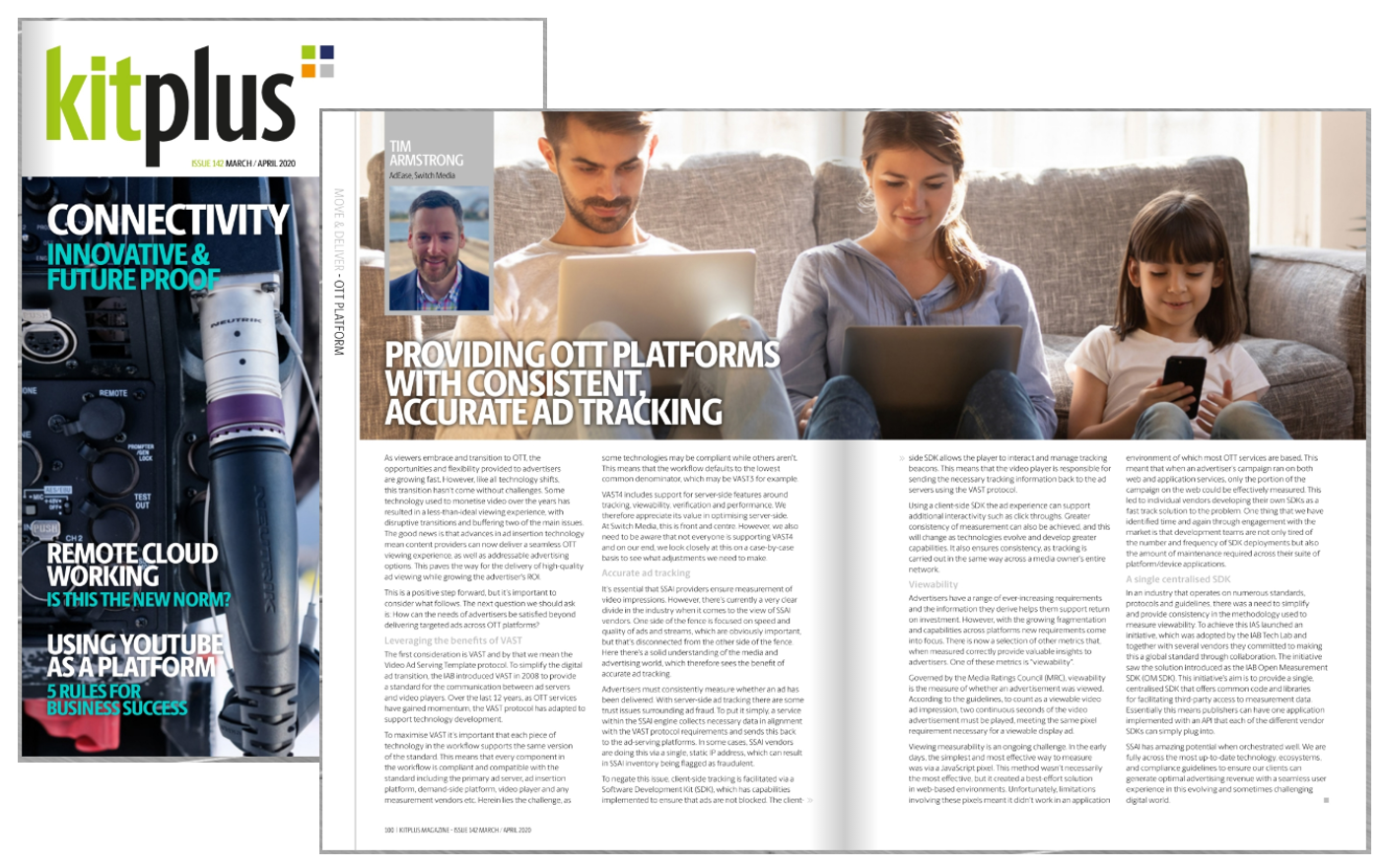Providing OTT Platforms with Consistent, Accurate Ad Tracking
As viewers embrace and transition to OTT, the opportunities and flexibility provided to advertisers are growing fast. However, like all technology shifts, this transition hasn’t come without challenges. Some technology used to monetise video over the years has resulted in a less–than–ideal viewing experience, with disruptive transitions and buffering two of the main issues. The good news is that advances in ad insertion technology mean content providers can now deliver a seamless OTT viewing experience, as well as addressable advertising options. This paves the way for the delivery of high-quality ad viewing while growing the advertiser’s ROI.
This is a positive step forward, but it’s important to consider what follows. The next question we should ask is: How can the needs of advertisers be satisfied beyond delivering targeted ads across OTT platforms?
Leveraging the benefits of VAST 
The first consideration is VAST and by that we mean the Video Ad Serving Template protocol. To simplify the digital ad transition, the IAB introduced VAST in 2008 toprovide a standard for the communication between ad servers and video players. Over the last 12 years, as OTT services have gained momentum, the VAST protocol has adapted to support technology development.
To maximise VAST it’s important that each piece of technology in the workflow supports the same version of the standard. This means that every component in the workflow is compliant and compatible with the standard including the primary ad server, ad insertion platform, demand-side platform, video player and any measurement vendors etc. Herein lies the challenge, as some technologies may be compliant while others aren’t. This means that the workflow defaults to the lowest common denominator, which may be VAST3 for example.
VAST4 includes support for server-side features around tracking, viewability, verification and performance. We therefore appreciate its value in optimising server-side. At Switch Media, this is front and centre. However, we also need to be aware that not everyone is supporting VAST4 and on our end, we look closely at this on a case–by–case basis to see what adjustments we need to make.
It’s essential that SSAI providers ensure measurement of video impressions. However, there’s currently a very clear divide in the industry when it comes to the view of SSAI vendors. One side of the fence is focused on speed and quality of ads and streams, which are obviously important, but that’s disconnected from the other side of the fence. Here there’s a solid understanding of the media and advertising world, which therefore sees the benefit of accurate ad tracking.
Advertisers must consistently measure whether an ad has been delivered. With server-side ad tracking there are some trust issues surrounding ad fraud. To put it simply, a service within the SSAI engine collects necessary data in alignment with the VAST protocol requirements and sends this back to the ad-serving platforms. In some cases, SSAI vendors are doing this via a single, static IP address, which can result in SSAI inventory being flagged as fraudulent.
To negate this issue, client–side tracking is facilitated via a Software Development Kit (SDK), which has capabilities implemented to ensure that ads are not blocked.The client-side SDK allows the player to interact and manage tracking beacons. This means that the video player is responsible for sending the necessary tracking information back to the ad servers using the VAST protocol.
Using a client-side SDK the ad experience can support additional interactivity such as click throughs. Greater consistency of measurement can also be achieved, and this will change as technologies evolve and develop greater capabilities. It also ensures consistency, as tracking is carried out in the same way across a media owner’s entire network.
Advertisers have a range of ever-increasing requirements and the information they derive helps them support return on investment. However, with the growing fragmentation and capabilities across platforms new requirements come into focus. There is now a selection of other metrics that, when measured correctly provide valuable insights to advertisers. One of these metrics is “viewability”.
Governed by the Media Ratings Council (MRC), viewability is the measure of whether an advertisement was viewed. According to the guidelines, to count as a viewable video ad impression, two continuous seconds of the video advertisement must be played, meeting the same pixel requirement necessary for a viewable display ad.
Viewing measurability is an ongoing challenge. In the early days, the simplest and most effective way to measure was via a JavaScript pixel. This method wasn’t necessarily the most effective, but it created a best–effort solution in web-based environments. Unfortunately, limitations involving these pixels meant it didn’t work in an application environment of which most OTT services are based. This meant that when an advertiser’s campaign ran on both web and application services, only the portion of the campaign on the web could be effectively measured. This led to individual vendors developing their own SDKs as a fast track solution to the problem. One thing that we have identified time and again through engagement with the market is that development teams are not only tired of the number and frequency of SDK deployments but also the amount of maintenance required across their suite of platform/device applications.
In an industry that operates on numerous standards, protocols and guidelines, there was a need to simplify and provide consistency in the methodology used to measure viewability. To achieve this IAS launched an initiative, which was adopted by the IAB Tech Lab and together with several vendors they committed to making this a global standard through collaboration. The initiative saw the solution introduced as the IAB Open Measurement SDK (OM SDK). This initiative’s aim is to provide a single, centralised SDK that offers common code and libraries for facilitating third-party access to measurement data. Essentially this means publishers can have one application implemented with an API that each of the different vendor SDKs can simply plug into.
SSAI has amazing potential when orchestrated well. We are fully across the most up–to–date technology, ecosystems, and compliance guidelines to ensure our clients can generate optimal advertising revenue with a seamless user experience in this evolving and sometimes challenging digital world.







